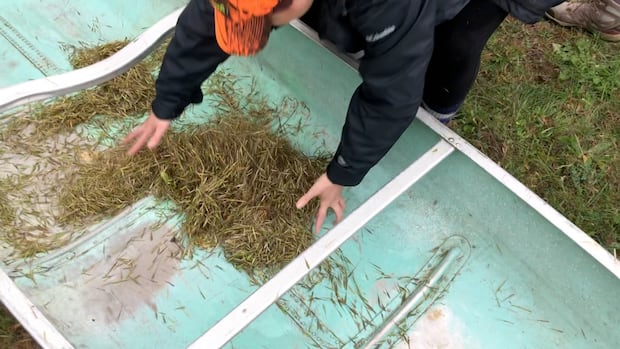IndigenousLate summer or early fall is harvesting season for wild rice, or manoomin as it’s known in Anishinaabemowin, and Manitoba is one of Canada’s largest producers.Restaurateur says wild rice is simple to prepareStefan Richard · CBC News · Posted: Aug 26, 2025 5:52 PM EDT | Last Updated: 38 minutes agoStudents in northwestern Ontario remove harvested wild rice from the bottom of a canoe in the fall of 2019. (Ron Desmoulins/CBC)Late summer or early fall is harvesting season for wild rice, or manoomin as it’s known in Anishinaabemowin, and Manitoba is one of Canada’s largest producers.In 2024 Manitoba exported roughly $2 million in wild rice, about 36 per cent of Canada’s wild rice export value, according to the provincial government. Az Klymiuk, an associate professor of Biological Sciences at the University of Manitoba, wants to understand how wild rice can be incorporated into food production and wealth creation for Indigenous communities. “It’s harder to go and harvest wild rice than it is to harvest a moose. It takes a lot longer,” Klymiuk said.”It’s a lot cheaper to go and buy mac and cheese from the store than it is to go out in a canoe and harvest this really protein-rich, antioxidant-rich, wonderful country food.”The yield at harvest time can vary from year to year depending on water levels, Klymiuk said. Az Klymiuk is an associate professor of Biological Sciences at the University of Manitoba. (Az Klymiuk)”If you’re out canoeing, you’ll see it growing up to a metre deep and then as you move into the cattails, it’ll kind of peter off,” Klymiuk said. “It doesn’t compete very well with cattails but you can find it if there are no other plants growing along a margin. You’ll find it from 20 centimetres depth out to fully a metre.”Harvesting the grain involves paddling a canoe into the shallow water beds where a stick fixed with a special hook is used to pull the rice into the boat.Versatile grainTara Mostrom, who is Anishinaabe from Mille Lacs Band of Ojibwe in Minnesota, is general manager of Owamni by the Sioux Chef restaurant in Minneapolis, Minn.Owamni focuses on using locally-sourced ingredients from Indigenous owned producers. Mostrom said some of her early memories revolve around wild rice.”My mom’s boyfriend would go ricing and then he’d come back and then we’d help process it,” she said.Processing the wild rice needed community help.”We would actually put a big huge tarp down, put all the unprocessed seeds and rice on the tarp, and then we would have kids literally just dance on it,” Mostrom said.The vibrations removed the husks from the grain.”And that’s traditionally how some Ojibway would do it,” she said. “That really helps to not break the rice because usually you wear moccasins when you do it.”Tara Mostrom is the general manager of Owamni by the Sioux Chef restaurant in Minneapolis, Minn. (Tara Mostrom)Mostrom said the Owamni kitchen goes through hundreds of pounds of wild rice each week, served plain or in vegan dishes, like paired with beans as a meat substitute in picadillo.If you buy it for your own kitchen, wild rice’s uses and tastes are unique but its preparation is simple, Mostrom said. Boil it for 35-55 minutes before steaming for 10 minutes.”Two knuckles above the rice, that’s as much water as you should put in,” Mostrom said.ABOUT THE AUTHORStefan Richard is a reporter for CBC Indigenous, based in Treaty 1 territory. His work has appeared on APTN, NPR, Corus Radio, Native Communications Inc., and Slam Wrestling. Stefan is a proud member of Sagkeeng Anicinabe Nation.
Monday, 22 Dec 2025
Canada – The Illusion
Search
Have an existing account?
Sign In
© 2022 Foxiz News Network. Ruby Design Company. All Rights Reserved.
You May also Like
- More News:
- history
- Standing Bear Network
- John Gonzalez
- ᐊᔭᐦᑊ ayahp — It happened
- Creation
- Beneath the Water
- Olympic gold medal
- Jim Thorpe
- type O blood
- the bringer of life
- Raven
- Wás’agi
- NoiseCat
- 'Sugarcane'
- The rivers still sing
- ᑲᓂᐸᐏᐟ ᒪᐢᑿ
- ᐅᑳᐤ okâw — We remember
- ᐊᓂᓈᐯᐃᐧᐣ aninâpêwin — Truth
- This is what it means to be human.
- Nokoma











